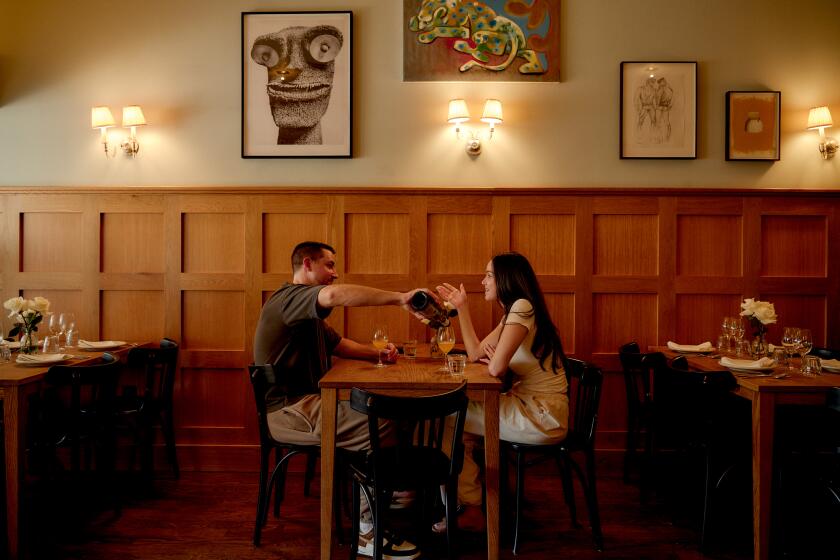The Joy of Remembering : Reminiscences: A crumbling 1943 edition of Irma S. Rombauer’s “The Joy of Cooking” opens a flood of memories, a chronicle of three generations.
It’s an unlikely object for anyone’s affection--a crumbling 1943 edition of Irma S. Rombauer’s “The Joy of Cooking.”
The cover is a faded robin’s-egg blue with cream-colored lattice work. There’s an indentation circling the author’s first name where someone rested a drink long ago. From the shape and size of the imprint, it must have been a cocktail glass. And from the way the liquid ate through the canvas cover, it could only have been one of my grandfather’s lethal whiskey sours.
I can still see my father’s face every time his in-law handed him the cherry-laden drink. Dad would return my grandfather’s smile, then clutch his throat, gagging, the moment Granddaddy turned his back.
“Worst damn drink I’ve ever had,” my father invariably would grumble during the drive home.
Some families have Bibles listing the clan’s history. We have “The Joy of Cooking.” Instead of recalling statistical names and dates, this opens a flood of memories, a chronicle of three generations.
And this isn’t just a record of special occasions, although the book does boast the complete menus of holiday dinners when my brother and I were banished to a lopsided card table while the adults took forever to finish their jellied consomme, roast turkey and creamed vegetables. This book is brimming with slips of paper noting everyday recipes and the small events that make up a life.
The cookbook originally belonged to my grandmother, who replaced her original 1933 edition when the binding became hopelessly cracked. She shifted her own recipes and notes to the new book, so some are from the 1920s and ‘30s. My mother passed it on to me when I moved to New York after college.
“Gee, thanks,” I mumbled when handed the tattered book. I was headed for my first job in the Big City, and my only possessions were a few career clothes and a 40-year-old cookbook. Little did I know what surprises and revelations that book would unfurl, slowly and at its own unhurried pace.
Most of the writing is in my grandmother’s hand, a hasty scrawl in pencil or fountain pen. I remember her as a confused, reclusive woman; she was afflicted with what we now realize was Alzheimer’s disease in the mid-1950s, before I was born.
But when she was young, she was known for her wicked wit and a mean ragtime piano played on an ancient Steinway grand. One time, long after she had forgotten who I was, I heard the clinking of an out-of-tune piano. There I found her, cigarette dangling from her mouth, pounding a rhythmic snatch of the “Maple Leaf Rag.” She looked at me, winked, and said, “Hiya, kid!” before returning to her music.
That’s the grandmother who scribbled in the cookbook. Through these pages I’ve come to know her, a vivacious hostess who always seemed to cook for a crowd. She was too busy to put every recipe she picked up from friends, from magazines and the radio into her wooden recipe file, so she would slip them into her cookbook.
She probably meant to transfer them to a proper file one day but never found the time. Every time I open the book, a new recipe appears, yellowed and faded but dotted with grease stains from the last time it was followed.
Even the endpapers of the book are crammed with recipes from friends. Mrs. Bolmer’s chicken and rice, and the Ballards’ rum balls are all noted.
Two of them--cranberry jelly and Addie’s date pudding--were from my Aunt Addie. She was an old woman with jet-black hair and a vague camphor smell, and she always entered family gatherings with a quivering mound of tomato aspic. Before serving, she would stop at every plate and dish out the gelatinous mold, dolloping each with a generous spoonful of mayonnaise sprinkled with paprika.
I can still see my Uncle Smith (a man so old he had served as a physician in the Spanish-American War and could recall the time Jefferson Davis was a surly house guest) chewing every bit of the tomato aspic 50 times. If he lost track, he’d start over.
There is no mention of Aunt Addie’s tomato aspic, and I can merely assume that my grandmother disliked it as much as I did. Only now I realize I had a kindred spirit at those meals.
Some of the recipes are on paper with commercial letterheads, such as “Ship it on the ‘Frisco” and “Fleischmann’s Yeast for Pep.” A couple have telephone numbers with names like “OLIVE-1500.” That was before touch-tone phones and anonymous tidbits. The sheer variety of business note pads is testimony to my grandfather’s struggle during the Depression, a time when no job was turned down and companies folded before the ink was dry on their new letterheads.
In the margins of the recipes themselves are notations judging them “good,” “so-so,” and reminders to “use very good meat.” She also notes how recipes could be doubled.
This edition of “The Joy of Cooking” has a few “Hardtime Emergency” chapters with tips on stretching rations and meat substitutes. There are general rules for cooking and a few paragraphs on how to prepare an unplucked chicken (after burning off feathers with a flame, Rombauer suggests you “cut off the head” and “draw out entrails . . . . Now cut off the feet”).
Cookbooks rarely speak to you the way this one does. I’ve seen a newer edition, and while it’s handy, it lacks the folksy intimacy and calm conversational tone of Rombauer’s original volume. The old book is like having a companion in the kitchen, advising every move and nodding approval as you cook. This volume is really two cooks: Rombauer and my own grandmother, so there’s an extra measure of security with every recipe.
Since my family is from St. Louis, the author’s home town, there’s an added sense of kinship. My grandmother had a slew of friends who knew Rombauer. One of my mother’s schoolmates, as a young newlywed in the late ‘40s, looked her up in the telephone book when her sauce clotted just before giving her very first dinner party. Rombauer kept the frantic bride on the telephone as she talked her through rescuing the sauce. Can you imagine giving Martha Stewart a jingle?
I also love the calorie chart, which lists cocktails along with the other nutrients needed to support life. For example, the Manhattan is wedged between malted milk and maple syrup. And old-fashioned is between okra and olive oil. This was clearly a woman with priorities.
Most of the recipes sound wonderful, with lavish use of butter and cream. One of the recipes, Gaston beef stew, was the first dish my mother learned to cook as a newlywed. Paging through the book, I can almost smell the fragrance of caramelized carrots and see my mother making cake frosting over a double boiler. Some of the “fast, easy” recipes involve hours in the kitchen; no microwave instructions here.
Others sound simply awful, such as tripe piquante , liver patties (Rombauer mentions that “Today liver is de rigueur “) and creamed corned beef hash.
But whenever I want to know the basics--how to cook a roast, what to do with a head of cabbage--I skip over all my sleek new cookbooks and head straight for my grandmother and Rombauer.
And whenever I feel nostalgic, I don’t turn to a photograph album, but to “The Joy of Cooking.”
The other day I picked it up, carefully. It’s much more fragile than the edition my grandmother replaced a half century ago, and so crammed with papers that it bulges at the sides. A slip of paper fluttered to the floor and I picked it up. It was one I’d never seen before. In my grandmother’s handwriting, it was titled “whiskey sour.”
Next time I visit my parents, my unsuspecting father has a real treat coming.
More to Read
Eat your way across L.A.
Get our weekly Tasting Notes newsletter for reviews, news and more.
You may occasionally receive promotional content from the Los Angeles Times.








